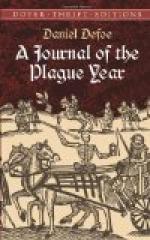It was indeed one admirable piece of conduct in the said magistrates, that the streets were kept constantly clear and free from all manner of frightful objects, dead bodies, or any such things as were indecent or unpleasant; unless where anybody fell down suddenly, or died in the streets, as I have said above, and these were generally covered with some cloth or blanket, or removed into the next churchyard till night. All the needful works that carried terror with them, that were both dismal and dangerous, were done in the night. If any diseased bodies were removed, or dead bodies buried, or infected clothes burned, it was done in the night; and all the bodies which were thrown into the great pits in the several churchyards or burying grounds, as has been observed, were so removed in the night, and everything was covered and closed before day. So that in the daytime there was not the least signal of the calamity to be seen or heard of, except what was to be observed from the emptiness of the streets, and sometimes from the passionate outcries and lamentations of the people, out at their windows, and from the numbers of houses and shops shut up.
Nor was the silence and emptiness of the streets so much in the city as in the outparts, except just at one particular time, when, as I have mentioned, the plague came east, and spread over all the city. It was indeed a merciful disposition of God, that as the plague began at one end of the town first, as has been observed at large, so it proceeded progressively to other parts, and did not come on this way, or eastward, till it had spent its fury in the west part of the town; and so as it came on one way it abated another. For example:—
It began at St. Giles’s and the Westminster end of the town, and it was in its height in all that part by about the middle of July, viz., in St. Giles-in-the-Fields, St. Andrew’s, Holborn, St. Clement’s-Danes, St. Martin’s-in-the-Fields, and in Westminster. The latter end of July it decreased in those parishes, and, coming east, it increased prodigiously in Cripplegate, St. Sepulchre’s, St. James’s, Clerkenwell, and St. Bride’s and Aldersgate. While it was in all these parishes, the city and all the parishes of the Southwark side of the water, and all Stepney, Whitechapel, Aldgate, Wapping, and Ratcliff, were very little touched; so that people went about their business unconcerned, carried on their trades, kept open their shops, and conversed freely with one another in all the city, the east and northeast suburbs, and in Southwark, almost as if the plague had not been among us.
Even when the north and northwest suburbs were fully infected, viz., Cripplegate, Clerkenwell, Bishopsgate, and Shoreditch, yet still all the rest were tolerably well. For example:—
From the 25th of July to the 1st of August the bill stood thus of all diseases:—




